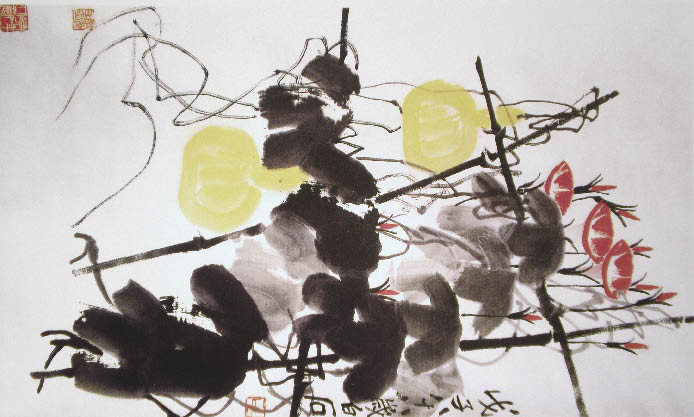|
Chinese landscape painting was initiated in the Sui and Tang dynasties (581-907), and matured in the Five Dynasties (907-960). Painters in this period took a realistic approach to achieve accurate details. Freehand expressionism flourished in the Yuan Dynasty (1271-1368). In contrast with painters in the Five Dynasties, artists in this period valued the expression of thought through their work. In this period the technique of using brush and ink saw unprecedented development. However, by the Qing Dynasty, imperial painters had restored the old rules, but creative painters outside the court not only learnt from ancient people but also from nature, creating many works of great vitality.
The art of Chinese bird-and-flower painting matured in the Five Dynasties. The works of the court painter Huang Quan (circa 903-965) mainly deal with rare flowers and animals. His gorgeous paintings represent a rich and imposing style. He employed a traditional Chinese painting method featuring fine brushwork, heavy exuberant color, and detailed descriptions. In Chinese his style is called “Huang Jia Fu Gui,” or “Huang’s Extravagance.”
Xu Xi (date of birth and death unknown) of the Five Dynasties was a hereditary aristocrat. He lived in the countryside and never held an official position. Instead, he liked painting flowers and plants. He adopted a freehand style, pursuing simplicity free of adornment, earning his approach the name “Xu Xi Ye Yi,” or “Xu Xi’s Wild Charm.”
These two styles provided the basis for Chinese bird-and-flower painting. Later Huang Quan’s style prevailed and further developed through generations of imperial painters. Xu Xi’s style flourished, however, during the Yuan Dynasty, and was upheld by the literati during the Ming and Qing dynasties.
Famous Painters of Modern China
Modern Chinese painting is built on the traditions of ancient Chinese art. At the same time, it incorporates a lot of Western techniques. Modern painters can be divided into two groups: one, represented by Qi Baishi, Huang Binhong and Zhang Daqian, is more traditional and their works are close to ordinary people’s daily lives; the other is represented by Xu Beihong and Lin Fengmian, and is deeply influenced by Western reformist painters and the artists’ experiences studying abroad.
Qi Baishi was born in Xiangtan, Hunan Province and grew up in a poor family. He once worked as a carpenter. He started his painting career by making copies of ancient artists’ works. He studied poetry, essay writing, and calligraphy, and traveled mountains, rivers and places of historic interest. Through lifelong study and work he became a great artistic master of his time.
 |
| Morning Glory and Calabash by Qi Baishi. |
Qi Baishi believed that paintings should be based on reality rather than imagination. He strived to capture the inner spirit of flowers, birds, insects and fish, and the creatures created by his brush indeed look vivid and real. He theorized that, “Paintings must be something between likeness and unlikeness; too much likeness is vulgar, but too little likeness cheats people,” a statement which sums up the true essence of Chinese painting.
It is generally known that Qi was good at painting shrimp. With simple lines he was able to paint lively impressions of these creatures. Besides painting, he was also a master seal-carver, calligraphist, poet and essayist. He creatively bridged the aesthetic conceptions of ordinary people and traditional literati, helping to eliminate the gap between the two groups. In this way, his works are of universal appeal. Qi Baishi is regarded as an outstanding representative of Chinese painting, and his great contribution to Chinese art has made the international community pay greater attention to Chinese painting.
| 